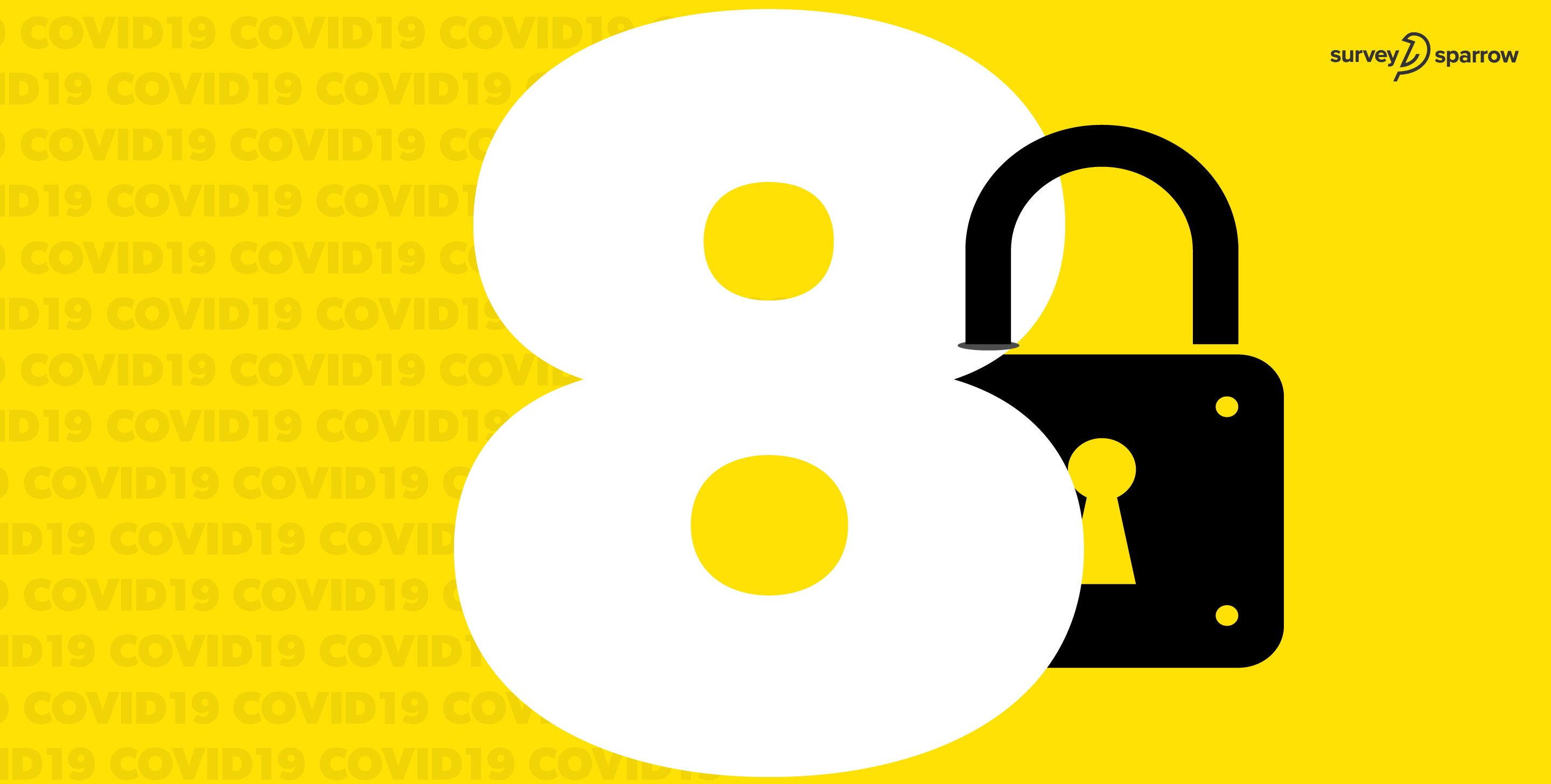15 Working NPS Follow-Up Questions That Get The Job Done!

Kate Williams
Last Updated: 21 August 2024
19 min read

Net promoter score (NPS) is by far the most significant metric to gauge your customers’ loyalty. But the thing is, you can’t retain loyalty with scores. Your customers’ sentiments and opinions aren’t measurable with just a number. And this is where the NPS follow-up survey comes in.
Think of an NPS survey as a conversation starter with your customers. But to keep the conversation going, you have to follow up with them.
NPS follow-up surveys are meant to build long-term relationships with customers. It allows engaging with them, improving your product, services, and brand image. So, if you want to provide a better customer experience and reduce churn, don’t be like Bob and master the art of follow-up.
And, to offer you a little help, here we will talk about what to do and what not to do on your NPS follow-up survey. We’ll also share 15 NPS follow-up questions that you can use to kick-start an amazing conversation.
So, without further ado, let’s dig in!
What Is NPS Follow-up Question?
NPS follow-up questions are those questions that help you gather feedback on why a customer provides a particular score.
As you may know, the NPS score ranges from 0 to 10, which makes it easy to quantify customer loyalty and satisfaction. But to understand why exactly a customer provided that score needs a bot more work. That's where this follow-up question comes into play.
These follow-up questions are often open-ended, allowing customers to provide deeper feedback.
Pro Tip 💡: Using such follow-up questions, you can understand a customer's emotions behind the feedback.
If you are using tools like SurveySparrow, which offers advanced text analytics software, you can understand the precise sentiments behind each feedback. And that's just scratching the surface. By understanding the 'WHY' behind the NPS score can help you improve your offerings for the better.
Why You Should Focus More on Following Up?
Once you’ve learned who your promoters, detractors, and passives are, it’s time to follow up with them. If you’re in marketing, you probably already know the value of follow-up.
If you have never been into marketing, sales, or any other position to realize the importance of follow-up, let me break this to you.
Follow-up is the ultimate opportunity for your business to build a long-term relationship with customers. It’s an opportunity to show them the value proposition of your product. And, most importantly it’s an opportunity to undo all the wrongs and faults of your product to put your business back in the game!
But shockingly, 97% of organizations don’t send follow-up emails to see if their customers are satisfied with their services. Following up can help you enhance the overall customer experience.
Even sometimes, you can detect problems before they arise. Also, following up with your customers shows that you care about their opinion and is open to resolving their issues.
Following Up with the Promoter
NPS promoters- these are the people who will stay loyal to your brand forever. They’ll advocate for your products; they’ll be excited to get mail from you. In short, promoters are happy customers who always think positively about your brand.
Now, you can use their positive experience to understand what they liked about your product or services. You can send them NPS follow-up questions to determine if there’s a specific feature that stands out to them. Based on their responses, you can analyze your business strengths and competitive advantages.
By following up, you can encourage your promoters to share positive reviews about your brand on social media channels. Ask them to provide more feedback on their overall experience with your product. You can even reward your customers with a special offer or bonus to improve their satisfaction and loyalty.
For example, you can send them a follow-up NPS email like-
“We’re so glad to hear that you liked our product! Please review our product on our social media channels and let others know about your experience. Your experience can be what they’re missing out on!
And, as a thank you, We’re giving away a 30-day free trial subscription to the first five customers who review us!”
Following Up with the Detractor
Following up with your detractors is by far the most crucial task. Why? Because there’s a big chance, you may lose these customers. A low rating from the detractors can be disheartening, but it’s also a golden opportunity to track down your business issues and solve them right away.
For example, let’s say you launched a CRM software in the market. You need customer feedback to understand the future of your software.
So, you sent an NPS survey to all your customers. And, some of your customers responded with a 5. That means they are the detractor, and they’re not satisfied with your product.
So, instead of ignoring these unsatisfied customers, you can send them an NPS follow-up to find out why they gave your product a low rating.
While following up with your detractors, keep one thing in mind, the goal is to reduce churn. So, make sure to send them a follow-up NPS email to address their issue and show them you value their opinion-
“Thanks for responding! We’re sorry that we couldn’t meet your expectations, and we love to get an opportunity to fix that.
So, let us know what we can do to make our services better?”
Now you know why engaging with promoters, passives, and detractors can help you win the business marathon. Next, we’ve shared some proven and tested NPS follow-up questions for you to conduct an amazing survey!
So, what’s the wait? Let’s scroll down…
15 NPS Follow-up Questions that Get the Job Done!
A standard NPS follow-up question has an open-ended format because open-ended questions help them express their opinion without any restrictions.
Take a glance at the examples of the open-ended questions below to use them alternatively on your next NPS survey.
1. We’d like to know what was lacking or where we disappointed you in giving the perfect experience?”
This is one of the greatest NPS follow-up questions to include in your follow-up survey. We’re calling this one the greatest because it gives you a chance to learn about the negative aspects of your services or product.
Negative feedback or criticism can be constructive for your business if you know how to use it. These types of questions allow your customers to point out the flaws your product might have and helps you improve that product for the future.
2. “We’d love to learn which features of our product impressed you the most?”
This question is simply made for the promoters and detractors. You can include this question to understand what your customers liked the most about your services or products.
With their feedback, you can learn the strengths of your product. Also, you can use the answers to this question as a testimonial. So, use the answers on your homepage, and landing page to showcase some social proof to your potential leads.
To roll out intriguing NPS surveys and schedule them, you can sign up for SurveySparow for free.
14-day free trial • Cancel Anytime • No Credit Card Required • No Strings Attached
3. “We’d like to know how we can improve your experience with us?”
If a customer gives you a rating between 7-8, then include these types of NPS follow-up questions on your NPS questionnaire. With this question, you gather insights from passive respondents to identify the flaws and mistakes of your product or service. Based on their feedback, you can work to improve their experience.
4. “Are we able to meet your expectations?”
Be it your customer service or a newly launched product, asking these kinds of NPS follow-up questions lets you know whether your service or product is the right fit for your customers. It will be best if you send this question to your satisfied promoters and passives.
However, you can avoid sending this question to NPS detractors because they probably haven’t found what they expected. The customer feedback to this question will help you develop your product based on your customers’ needs.
5. “Why did you choose us over our competitors?”
Every business always tries to make its services and products appealing to its target audience. And using competitor analysis, they can actually collect valuable insights to work on their growth opportunities.
Asking this NPS follow-up question to your promoters and detractors will help you track what your audiences think about your product that made them choose your product or switch to your competitors.
NPS benchmarks are another way to analyze your competitors in the market. Once your organization calculates the net promoter score, benchmarking it against your industry competitors will help understand your brand’s position.
6. “We’d like to know, what do you like the least about our product/brand?”
Again this is another classic question to find out where your business falls short.
You can send it off to detractors and passives to know how they feel about a specific feature of your organization’s service. From their responses, you can measure where you need to make some changes to provide an excellent customer experience.
7. “Would you like to show us some love and spread the word on social media channels?”
There’s nothing more appealing than a real customer sharing what they love about your product on social platforms. These social proofs can work like a charm to build your brand’s credibility. Again, you can include this question while following up with your Promoters to get some positive reviews.
8. “Thank you for the feedback! Would you like to tell us why you score us that way?”
These types of follow-up survey questions can be used for both promoters and detractors. You can always use the responses to measure your product’s faults and improve them accordingly.
Listening to your customer’s expectations and needs will help you provide a better customer experience.
9. “How do you benefit from using our services?”
This follow-up question helps you gather insights from different perspectives. For example, you launched an app that many customers like. Some of them love its dashboard’s design, some like its fast speed, while some purchased your product for ease of use.
The fact is, everyone, benefits from your product differently. That’s why this question is crucial to add to your survey questionnaire.
10. “Is there any competitor feature we don’t have but you’d like us to include?”
This question is a great chance to share their expectations and needs with your business for detractors and passives. They can tell you exactly where your business is lacking and what your competitors are doing better.
If you can use this response constructively and improve the flaws, you can easily convert your detractors into promoters.
11. “If there is one thing we could include in our product to make you happier, what would it be?”
Another alternative question you can include in your NPS follow-up survey questions is to learn if there’s any room for improvement. Today’s customers are aware of what is a great customer experience. And if you fail to reflect that in your business, it will increase the churn rate.
12. “If there is one thing we could change in our product to make you happier, what would it be?”
Each product comes with multiple features that make them stand out from the rest. However, your customers might not like all the features you provide.
Sometimes they can face issues with the login process, or maybe they don’t like the pricing. Asking this question allows them to share exactly what features stop you from getting good leads in the market. It will be better to send this question to your passive and detractor respondents to get a fair review.
13. “How would you describe our product to a close friend?”
Include this question to allow your customers to share as much as they would like about your brand. They could share how satisfied they are with the product features or give you some criticism. Whatever their response is, if you take the right actions, it will work in your favor.
14. “Can you please tell us, what could we have done differently to offer a better customer experience?”
Again this is a direct follow-up question for the detractors and passives. This question discovers deep insights about your customer service and other important aspects of your business that have caused trouble for your customers.
15. Thank you for taking the time to complete our survey! If you have any feedback on the survey, do let us know.
Well, this is not a question, but it’s extremely crucial to add this message at the end of your NPS follow-up questions. Your customers take out their time to willingly share their feedback with you. That’s why you must appreciate their effort with a short thank you message.
For promoters, you can say: “Thanks for the perfect score! You just made our day! We aim to provide you with the best product and services. And your opinion and suggestions are helping us to improve.”
For detractors, you can say: “Thank you for sharing your views with us! We value your ideas and continuously work on them to give you a personalized experience.”
Charged with the knowledge of these NPS follow-up survey questions, you can now create more engaging follow-up surveys. And to build a long-term relationship with your customer, you might know how to strategize the questions well. We’ll break down some actionable strategies to survey customers the right way in our next point.
More Examples of NPS Follow-up Questions
Here are some more examples of NPS follow-up questions you can use in your surveys. Hope it will be helpful.
- Could you let us know the reason behind your NPS score?
- What did we lack to disappoint you in giving the perfect experience?
- What features impressed you the most?
- How can we improve your experience with us?
- Do you have any specific areas in mind that we need to improve immediately?
NOTE: You can always create your surveys with SurveySparrow AI

6 Best Practices to Create NPS Follow-up Questions
If you are someone who likes the questions to be unique and wants them to be more tailored, then consider generating questions on your own. Just keep in mind the following best practices we have provided below. These are actually tips from our CX professionals, so they may be helpful for you.
Let's have a look at them.
Best Practice 1 - Personalize the Questions
There's no one question for all. Each NPS score requires a unique follow-up question. For example, you can ask a detractor, "What did you love most about our product/service?" Can we? No!
So, make sure to personalize the questions.
Here's something you can follow -
- Promoters (10 & 9) - "What do you love most about our product/service?"
- Passives (7 & 8) - "What could do we do to earn a higher score from you?"
- Detractors (0 to 6) - "We are sorry to hear that. What specific improvements would you like to see in our offering?"
Related Read: How to convert detractors to promoters?
Best Practice 2 - Use Open-Ended Questions
We mentioned this in the beginning: most of the follow-up questions are open-ended. This is rather done on purpose. With open-ended questions, the respondents can express their thoughts freely.
To give you an example, see the following question.
What can we do to improve your experience with us?
Best Practice 3 - Keep it Simple and Concise
The last thing you need is to confuse your customers. The questions you ask should be clear and to the point. So, try to keep the questions simple, straightforward, and concise.
Best Practice 4 - Limit the Number of Questions
Have you ever heard of survey fatigue? That's what will happen if your survey goes on and on. A shorter survey has higher probablity of completion and can provide focused insights.
Too many questions can overwhelm the customers and may lead to a lower response rate.
Suggested Read: How to improve response rate the right way.
Best Practice 5 - Localize for Multilingual audience
For regions like the USA, the audience is rather diverse in race, language, religion, and more. Therefore, localizing your follow-up questions in the NPS surveys will be a good option. This way, customers can choose the language of their liking, leading to more accurate and valuable feedback.
NOTE: If you are using survey tools like SurveySparrow, you have nothing to worry about.
Through its multilingual survey feature, the tool supports over 130 languages, allowing you to reach out to global, diverse audiences.
Best Practice 6 - Consider Branding Your Surveys
Branding your surveys includes two things:
- Make sure the tone and style of your follow-up questions align with the brand identity.
- Include brand colors, logos, and design elements to enhance recognition and emotional connection.
By being consistent in the tone and style, you are reinforcing the brand image in your audience. Also, it makes the interaction feel more personal.
Similarly, by adding brand elements, you are making the surveys visually appealing and spreading the brand name.
How can you do this? Try using survey tools with white-label features - like SurveySparrow.
With the feature by your side, you can customize your surveys the way you want them and make them unique to your brand.
Try SurveySparrow's White-label Feature!
Customize your surveys and make it uniquely yours.
14-Day-Free Trial • Cancel Anytime • No Credit Card Required • Need a Demo?
How To Strategize The NPS Follow-Up Survey Questions To Start The Conversation?
Earlier in this post, we mentioned using open-ended questions, you can gather valuable insights from customers. However, as per a 2020 study, the average open rate of email is 18.0%, while the click-through rate is only 2.6%.
So, there’s a big chance your potential customer may not click through the net promoter score survey link. Or, worse, they may not even open the mail you sent them. So, to ensure all your customers open the mail and reply to your follow-up, you must strategize the survey incredibly well.
Here’s to help you, we’ve compiled a few crucial factors to consider before sending the first NPS follow-up survey.
Customize the Questions Based on the NPS Score
You can customize the follow-up ENPS or customer’s net promoter score surveys based on the rating you receive from previous NPS surveys. Again, as per a typical NPS survey, you can segment your respondents into three categories- Promoters, Passives, and Detractors.
If you’re sending the following survey to a promoter, your questions must reflect the excitement and joy of getting a positive response.
For instance, “We’re excited to know that you liked our product. Would you like to share what’s the one thing you liked the most?”
For passives and detractors, you must frame your questions in a way that reflects you care about their opinion and will take action to further improve your product.
Don’t Forget About Your Brand Voice
We live in an era where people stumble upon new products and technologies every day. It’s extremely difficult for new startups to secure a good place in the market. This is where branding comes into the picture.
As per a study, 94% of customers are likely to stay loyal to a brand that shows complete transparency. That’s why businesses need to stay true to their brand personality and voice in every channel. Even in surveys!
So, before crafting your NPS follow-up survey questions, make sure to use your brand’s unique voice. Focusing on brand voice will show that your organization cares about its customers, and they don’t send generic questions just for the sake of the survey.
For example, SurveySparrow’s brand voice is conversational, engaging, personal, and fun. We use gifs, images, and videos to keep the survey as friendly as possible. You can use our conversational survey forms, and NPS templates to create similar fun, informal follow-up surveys in the future.
Plan Your Goals Away
It’s crucial to set a goal before asking NPS follow-up questions to your customers. Setting goals will help you know exactly what to ask them and how you can use the responses for your growth.
For example, the goals for following up with a promoter can be asking for their testimonials, sharing their honest feedback, and understanding your business strengths. On the other hand, the goals for following up with detractors can be to learn more about their terrible experience, find ways to improve the overall experience, and retain them for the long term.
Automation is the Key
One of the most common issues many companies face is how often one should send a follow-up survey to the promoters and detractors.
The answer is not too soon, so they get annoyed, and not too late, so they forget about your brand. In short, you have to be persistent with the follow-up. You can send them about two follow-up surveys a week, or six follow-up questions in a month. The choice is up to you!
However, if you use survey software like SurveySparrow, you can automate your NPS follow-up questions accordingly. With this software, you can set up your NPS survey once and for all at any frequency- daily, weekly, or quarterly.
That’s All, Folks!
We’ve covered almost everything related to NPS follow-up questions. And, now, we hope that businesses have realized that customers aren’t retained with a number. It’s all about the follow-ups and how you keep the conversation going.
If you learn how to follow up with your promoters, passives, and detractors, you can learn how to turn them into your brand ambassador. All you need to do is listen to them closely and work on their suggestions. Yeah, it’s that simple!
So, go ahead and put some extra effort to survey your customers effectively to build relationships and reduce churn. Till then, keep asking, keep surveying!
14-day free trial • Cancel Anytime • No Credit Card Required • No Strings Attached

Kate Williams
Product Marketing Manager at SurveySparrow
Excels in empowering visionary companies through storytelling and strategic go-to-market planning. With extensive experience in product marketing and customer experience management, she is an accomplished author, podcast host, and mentor, sharing her expertise across diverse platforms and audiences.
You Might Also Like

Best Of
8 Positive Impacts to Look Forward to Post the COVID-19 Pandemic

Alternative
Top 10 AidaForm Alternatives to Boost Your Data Collection Efforts

Work Culture
The ultimate organizational culture definition! And 15 tips on how to make your culture the best.

Best Of
Employee Feedback Examples: 9 Actionable Tips in 2024

Turn every feedback into a growth opportunity
14-day free trial • Cancel Anytime • No Credit Card Required • Need a Demo?
